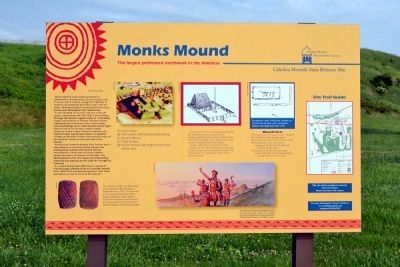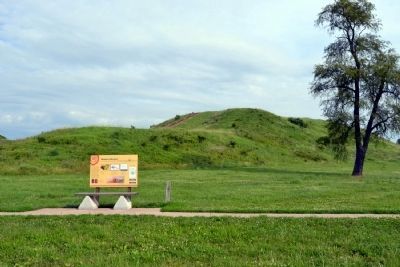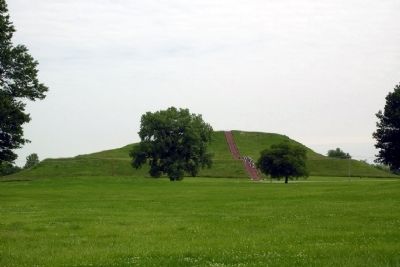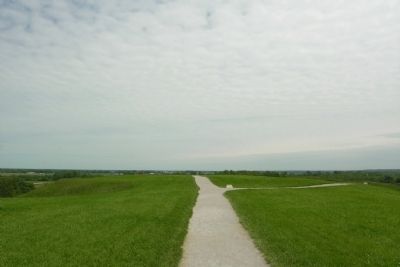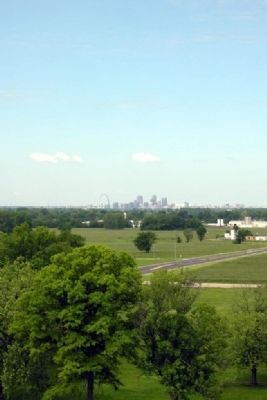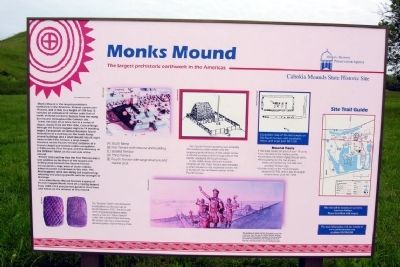Near Collinsville in Madison County, Illinois — The American Midwest (Great Lakes)
Monks Mound
The largest prehistoric earthwork in the Americas
Monks Mound is the largest prehistoric earthwork in the Americas. Its base covers over 14 acres, and it rises to a height of 100 feet. It contains an estimated 22 million cubic feet of earth, all hand-carried in baskets from the many borrow pits through the Cahokia site.
It was not built all at once. But in a series of stages, mostly from AD 950-1200. Core-drillings through the mound suggest eight to 14 building stages. Excavations at various locations found indications of a stairway on the South Ramp; several buildings and a small mound rebuilt eight times on the First Terrace; a large temple structure on the Fourth Terrace; evidence of a French chapel and historic Indian occupation (1730s) on the First Terrace; and the discovery of the Birdman Tablets on the east side of the mound.
Recent tests confirm that the First Terrace was a late addition to the front of the mound and drilling deep beneath the Second Terrance encountered a large mass of stone cobbles whose function is unknown at this time. The Mississippians were also doing soil engineering, selecting and placing specific soils for strength or drainage.
It is called Monks Mound because a group of French Trappist Monks lived on a nearby mound from 1809-1913 and planted gardens, fruit trees and wheat on the terraces of this mound.
(Lower Left Image Caption)
The “Birdman Tablet” was discovered in excavations on the east side of Monks Mound in 1971. The front side of this engraved sandstone tablet depicts a man in a “falcon dancer” outfit, with a beaked mask and wing; the reverse side has a cross-hatched diamond patterns representing a snake.
(Upper Center Illustration Caption)
The Fourth Terrace building was probably the residence of the leader and the religious/political focus of this urban center. A fenced courtyard with a huge post in the center, enclosed the fourth terrace.
In the 1830s Amos Hill built his farm complex on the Third Terrace and removed a small mound on the southeast corner. He is buried on the northwest corner of the Fourth Terrace.
(Lower Center Illustration Caption)
The paramount chief and his attendants greet the rising sun from the top of Monks Mound. Among some later Mississippian peoples in the Southeast the chief was believed to be related to the Sun and that may have been true at Cahokia as well.
(Upper Center Map Caption)
Excavation map of the last temple on the fourth terrace—with courtyard, fence, and large post AD 1150
Mound Facts
- The base covers an area of over 14 acres.
- It is 100 feet at the highest point.
- It contains 22 million cubic feet of earth.
- The building on the top terrace measured 48 feet by 104 feet and possibly 50 feet high.
- Construction of the mound began around AD 950, and it was enlarged several times until AD 1250.
Erected by Cahokia Mounds State Historic Site.
Topics. This historical marker is listed in these topic lists: Anthropology & Archaeology • Native Americans • Settlements & Settlers. A significant historical year for this entry is 1971.
Location. 38° 39.545′ N, 90° 3.666′ W. Marker is near Collinsville, Illinois, in Madison County. Marker can be reached from Collins Ln, 0.1 miles north of Collinsville Rd. Collins Lane ends in a parking lot for Monks Mound. Marker is on the trail from the parking lot to Monks Mound. Touch for map. Marker is in this post office area: Collinsville IL 62234, United States of America. Touch for directions.
Other nearby markers. At least 8 other markers are within walking distance of this marker. Monks Mound - South Ramp (about 300 feet away, measured in a direct line); Monks Mound - Southwest Corner (about 500 feet away); Monks Mound - 4th Terrace (about 600 feet away); The Stockade Path (about 600 feet away); Mound 51 (about 700 feet away); Cahokia (about 700 feet away); Mound 50 (about 800 feet away); Stockade (approx. 0.2 miles away). Touch for a list and map of all markers in Collinsville.
Also see . . . Cahokia Mounds State Historic Site. Official website of Cahokia Mounds State Historic Site. (Submitted on December 27, 2012, by Duane Hall of Abilene, Texas.)
Credits. This page was last revised on March 25, 2023. It was originally submitted on December 27, 2012, by Duane Hall of Abilene, Texas. This page has been viewed 1,090 times since then and 44 times this year. Photos: 1, 2. submitted on June 26, 2014, by Duane Hall of Abilene, Texas. 3, 4, 5, 6. submitted on December 27, 2012, by Duane Hall of Abilene, Texas. • Bill Pfingsten was the editor who published this page.
